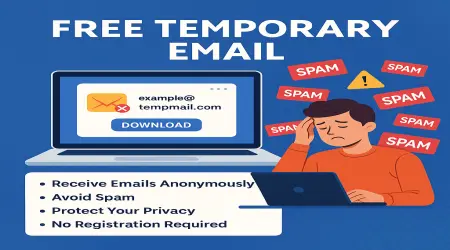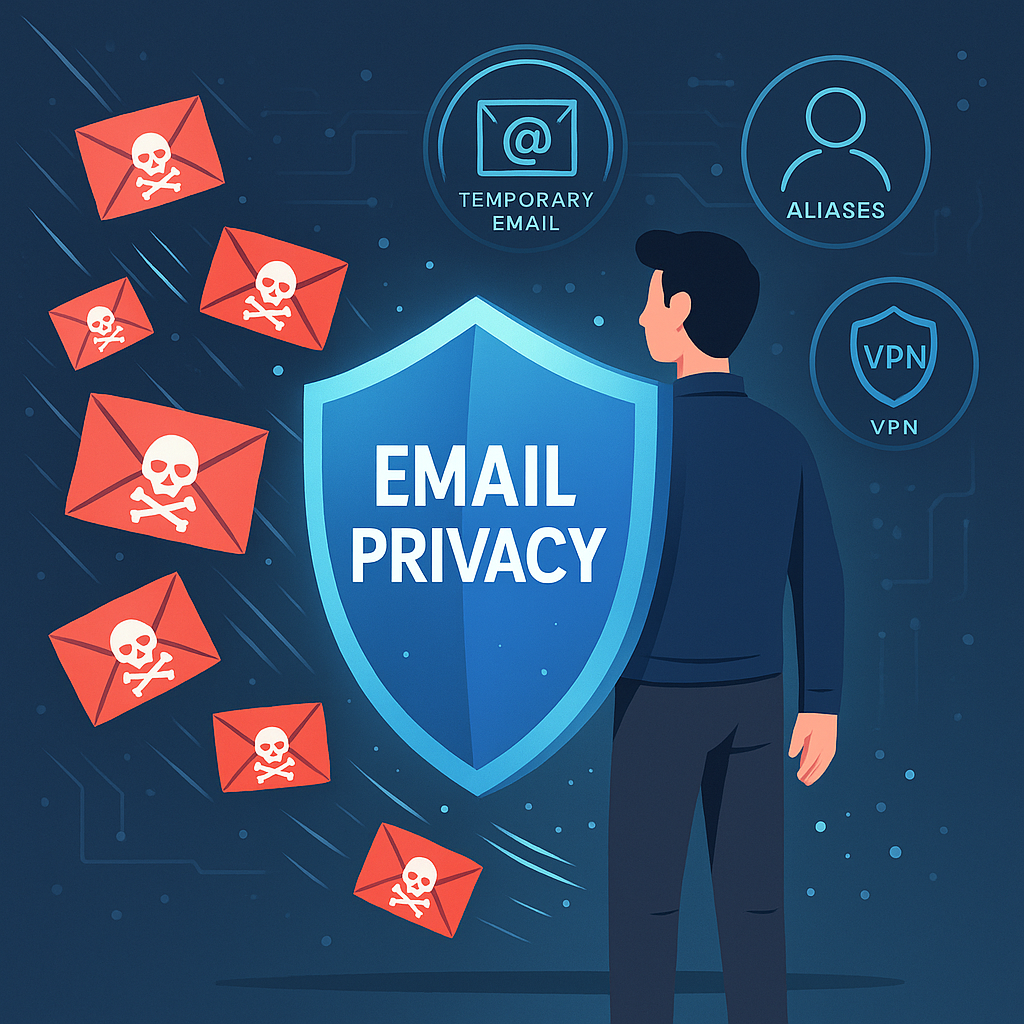

How to Hide Your Email Address Online in 2025 Without Breaking the Internet
Introduction
Email remains the backbone of digital communication in 2025. From social media logins to online shopping receipts, your email address is at the center of your digital identity. Yet this convenience comes with a cost: privacy risks. Public exposure of email addresses leads to spam, phishing attacks, identity theft, and unwanted marketing.
The challenge? Hiding your email address without breaking critical services like password resets or essential notifications. In this ultimate guide, we’ll cover why email privacy matters, common risks, modern privacy tools (like temporary emails, aliases, and encryption), and actionable strategies to hide your email address online while maintaining seamless connectivity.
Why Hiding Your Email Address Matters in 2025
1. Explosion of Spam and Phishing
Over 50% of global emails sent daily are spam. Sophisticated phishing campaigns target emails leaked in data breaches, costing businesses and individuals billions.
2. Data Breaches at Record Levels
Major platforms — from e‑commerce giants to social media — continue to experience breaches exposing millions of email addresses.
3. Email as a Universal Identifier
Your email is tied to banking, work, and personal accounts. One leak can compromise multiple services.
4. Rise of Data Brokers
Data brokers collect and sell email‑linked profiles, tracking user behavior for targeted ads and analytics.
Common Ways Email Addresses Get Exposed
Public Social Media Profiles: Many people unknowingly display emails on LinkedIn, Facebook, or Instagram.
WHOIS Records: Domain owners may expose emails in public registry data.
Online Forms: Signing up for freebies, contests, or newsletters without disposable solutions.
Data Breaches: Hackers exploit weak security measures to steal user data.
Phishing Pages: Fake websites trick users into entering personal details.
Myths About Hiding Your Email Address
Myth 1: “Just Don’t Share It Online”
Reality: Even if you avoid public posting, your email leaks through breaches or third‑party trackers embedded in sites you use daily.
Myth 2: “Using Complex Passwords Is Enough”
Reality: Strong passwords protect accounts, not the visibility of your email address itself.
Myth 3: “Encrypted Messaging Replaces Email”
Reality: Email remains mandatory for most services; total replacement is unrealistic.
Myth 4: “Temporary Emails Solve Everything”
Reality: They’re excellent for short-term privacy but unsuitable for long-term professional use.
Strategies to Hide Your Email Address Without Breaking the Internet
1. Use Temporary (Disposable) Email Addresses
Temporary emails (e.g., Temporary‑Email.net) generate short-lived, anonymous addresses for one-time sign-ups, downloads, or testing services.
Pros:
No personal data required
Auto-expiration removes traces
Ideal for newsletters, freebies, and risky platforms
Cons:
Not suitable for long-term accounts
Public inboxes on some providers
2. Create Email Aliases
Services like ProtonMail, SimpleLogin, or AnonAddy allow you to create aliases — unique addresses that forward to your main inbox.
How it works:
Each alias masks your real email.
You can disable any alias receiving spam.
Perfect for separating personal, work, and sign-up accounts.
3. Use Encrypted Email Services
Providers like ProtonMail or Tutanota encrypt messages end‑to‑end, protecting content even if emails are intercepted.
Advantages:
Strong privacy from prying eyes
Ideal for sensitive communications
Works seamlessly with aliases for extra masking
4. Enable Two-Factor Authentication (2FA)
Even when hiding your email, 2FA adds an additional security layer — essential for accounts tied to your real identity.
5. Obfuscate Emails on Public Pages
If you must display an email publicly (e.g., for business):
Write it as
name [at] domain [dot] comUse JavaScript to render it dynamically, preventing bots from scraping
6. Separate Emails for Different Purposes
Maintain three tiers of email addresses:
Primary email for banking and personal accounts
Alias email for shopping and newsletters
Temporary email for one-time sign-ups
7. Use VPNs with Email Services
A VPN hides your IP address when signing up or accessing email accounts, adding a layer of anonymity and preventing geolocation tracking.
8. Regularly Audit Your Email Exposure
Use tools like Have I Been Pwned to check if your email appears in data breaches and rotate emails or aliases when necessary.
Tools for Hiding Your Email Address in 2025
1. Temporary‑Email.net
Private disposable emails
Auto-expiration (10–60 minutes)
Ideal for developers and privacy-conscious users
2. SimpleLogin
Create unlimited aliases
Disable compromised addresses instantly
Integrates with Proton ecosystem
3. ProtonMail
Encrypted email service with alias support
Swiss‑based with strict privacy laws
4. AnonAddy
Open‑source alias generator
Custom domains supported for advanced users
5. 10MinuteMail
Classic 10-minute disposable inbox
Great for quick verifications
6. Guerilla Mail
Customizable usernames
Extended expiration options for testing
Comparison Table: Email Privacy Tools (2025)
| Tool | Type | Privacy Level | Best Use Case | Cost |
|---|---|---|---|---|
| Temporary‑Email.net | Disposable | High | One-time sign-ups | Free |
| SimpleLogin | Alias Service | High | Managing multiple accounts | Freemium |
| ProtonMail | Encrypted | Very High | Sensitive communications | Freemium |
| AnonAddy | Alias Service | High | Developer-focused privacy | Freemium |
| 10MinuteMail | Disposable | Medium | Quick verification | Free |
| Guerilla Mail | Disposable | Medium | Testing bulk sign-ups | Free |
Combining Methods for Maximum Privacy
For best results:
Use aliases for recurring services (shopping, subscriptions)
Use temporary emails for one-off interactions
Host sensitive conversations on encrypted providers
Always pair with VPN and regular breach monitoring
Challenges When Hiding Your Email
Blocked Disposable Domains: Some platforms ban known temporary emails.
Password Recovery Issues: Losing access to disposable emails can block account recovery.
User Experience: Juggling multiple aliases or accounts requires discipline.
False Sense of Security: Masking your email doesn’t protect against malware or phishing if you still click malicious links.
Future of Email Privacy (2025 and Beyond)
Trends shaping the next generation of privacy tools:
AI‑powered spam and phishing detection
Integrated email masking in browsers (e.g., Firefox Relay)
Blockchain‑based disposable identities for tamper-proof anonymity
Passwordless authentication reducing reliance on email altogether
Actionable Tips to Start Hiding Your Email Today
Generate a temporary email for your next newsletter sign-up.
Create 2–3 aliases for shopping, forums, and personal use.
Switch sensitive accounts to encrypted services like ProtonMail.
Review your email exposure monthly using breach-checking tools.
Combine VPN and alias strategies for maximum privacy.
Frequently Asked Questions (FAQ)
Q: Is hiding my email address online legal?
Yes. Privacy tools are legal; misuse for fraud or impersonation is not.
Q: Can I completely disappear from data brokers?
No, but using aliases and temporary emails limits future tracking.
Q: Are temporary emails safe for banking or government accounts?
No. Use permanent, secure emails for critical services.
Q: How do I know if my email has been leaked?
Check “Have I Been Pwned” or similar breach monitoring services.
Q: Do disposable emails work for two-factor authentication?
Some do, but long-term 2FA should be tied to secure, permanent accounts.
Conclusion
Hiding your email address online in 2025 isn’t about vanishing from the internet; it’s about controlling your digital footprint. By combining temporary emails, aliases, encrypted services, and smart practices like VPN usage, you can minimize spam, protect sensitive accounts, and stay anonymous — without sacrificing usability.
The key is balance: mask your email where privacy is crucial, keep it visible where trust is required, and regularly audit your exposure. In a world where data breaches are inevitable, proactive email privacy is no longer optional — it’s essential.
Target Keywords
hide email address online 2025, disposable email privacy, email alias tools, temporary email security, avoid spam email

